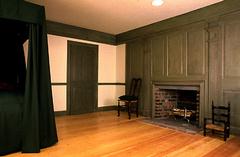Curriculum Materials: Art in America
|
|
Image 2b Foxon, Connecticut Questions: |
Think Questions Teacher Key
1. Why do you suppose the furniture was moved against the wall when the room was not in use? (To allow easier movement through the room.) How would the room look if the furniture was away from the walls and arranged throughout the room? How would you arrange the furniture?
2. PERIOD ROOMS are installations of actual rooms or portions of rooms that have been removed from historic houses. They tell us a lot about the people who lived in them. What can you deduce about the people who lived in this room from a farmhouse in Foxon, Connecticut? If you could have any room from your home placed in a museum, which room would you choose? Why? What could people learn about you and your family by studying the room you have chosen?
3. Look at the chair you sit in at school. Compare and contrast it to one of the chairs in the Connecticut Room. What material is each chair made of? Do you think your classroom chair is more or less comfortable than the Connecticut chair? Why? What color is each? How was color applied to each? Which chair do you consider more attractive? Why?
4. The people who lived in the Connecticut Room were a
bit behind the times in fashion trends. Why? (They did
not have a big city nearby like Boston or New York.) Do
you keep up with new trends and styles? How? Why did it
take a lot longer for people living in the 18th century to
find out about new styles? Do you ever hold onto things
even if they are out of style? Why? Why might the people
in rural colonial America have held on to their possessions
even if they were out of style? (It was not practical to
buy new things if the ones you already had were still
usable; the old styles may have reminded them of the homes
they left behind; perhaps they liked the things whether or
not they were in fashion.)
|
|
